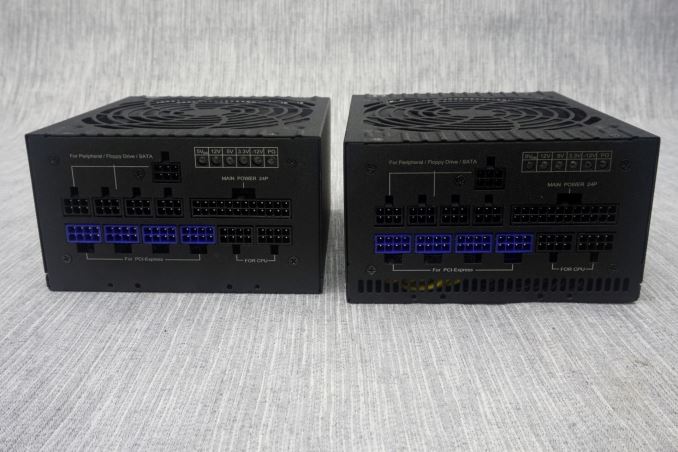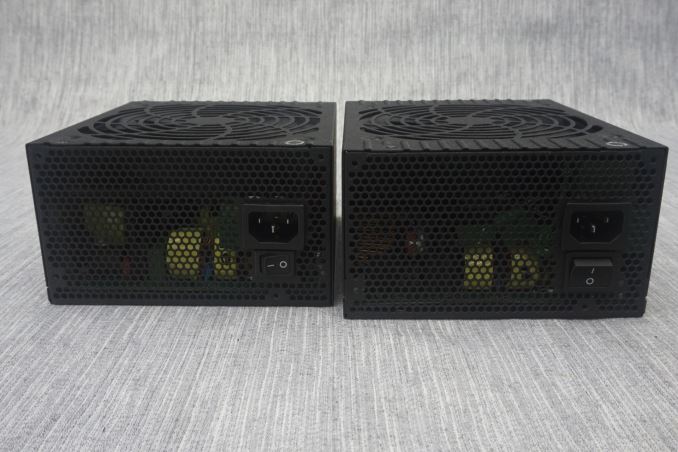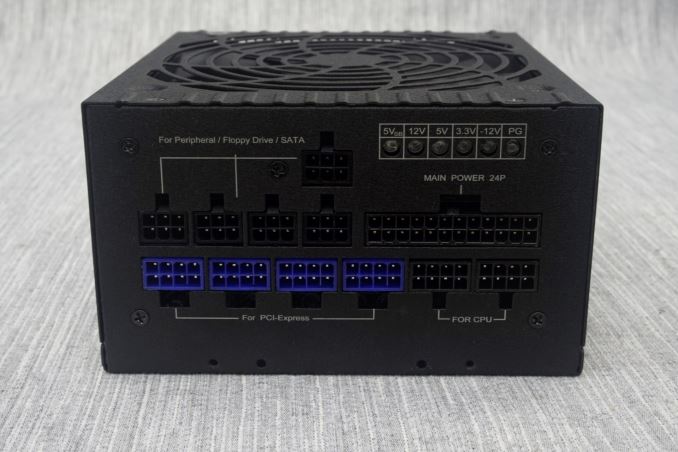The Rosewill Quark Series Power Supply Review (750W, 850W, 1000W, 1200W)
by E. Fylladitakis on January 13, 2016 9:00 AM EST- Posted in
- Cases/Cooling/PSUs
- Rosewill
- 80Plus Platinum
External Appearance
Rosewill went with the common "black goes with everything" approach for their Quark series units. The otherwise simple chassis is sprayed with a textured black paint that creates a sandstone-like visual effect. Instead of installing a removable finger guard, Rosewill cut the top cover to resemble a warped spider's web. There are no stickers or decorations on the sides of the chassis, the sticker with the specifications of the PSUs is placed at the top side of the units. The three most powerful Quark PSUs share the same exact chassis, while the 750W version is only slightly shorter.
The rear side of the PSUs is relatively uninteresting, with just a typical on/off switch and an AC power cable connector to be found there. Perhaps the only noteworthy observation is that the 750W unit has a smaller switch, as the larger units naturally have to cope with a larger input current.
While it is not strange for the rear side of these PSUs to be very similar, their front sides are peculiarly identical as well. All of the units share the same number of connectors, even though the smaller units do not come with enough cables for them. All of the connectors are black, with the exception of the PCI-Express connectors, which are blue. There are also six self-test LEDs near the top, five for the main voltage lines and one for the "Power Good" signal. These can be used to diagnose basic PSU issues.
Internal Design
Another difference between the 750W Quark and the more powerful versions is the fan. The 750W version has a Yate Loon D14BH-12 fan installed, a very powerful 140 mm fan, with a ball bearing engine and a maximum rotational speed of 2800 RPM. For the more powerful models, Rosewill went with a slightly smaller Young Lin Tech model, the DFS132512H, a 135 mm fan with a "hybrid" self-lubricating bearing and a maximum rotational speed of just 1700 PRM. Why Rosewill is installing such a powerful fan in the smaller models eludes us, as units capable of 80Plus Platinum efficiency with such a power output do not require these levels of airflow.
A glance on the insides of the Quark series PSUs instantly reveals that the 750W version is based on a similar, yet different platform than the rest. All are made by Enhance Electronics, with the 750W based on the 13XX Platinum platform and the more powerful units on the boosted 13XX Platinum GT platform. The 750W version has similar but notably smaller heatsinks and main transformer, while the secondary conversion stage MOSFETs can be seen from the top side of the main PCB, next to the transformer. The three larger PSUs have a larger secondary side heatsink and the secondary conversion MOSFETs are placed underneath the main PCB.
There is virtually no design difference between the 850W, 1000W and 1200W PSUs. Only the size and suppliers of the components change, with the mere exception that the 850W PSU has one input bridge rectifier and the larger units have two, with an extra smaller heatsink sandwiched between them.
The filtering stage of the 750W version consists of four Y capacitors, two X capacitors, two filtering inductors and a surge suppression MOV. Panasonic supplies the APFC 450V/560μF capacitor and all of the secondary side electrolytic capacitors come from Nippon Chemi-Con. Teapo supplies the polymer capacitors.
Enhance boosted the filtering stage of the 850W-1200W units slightly by adding two extra X capacitors. Rosewill's choice of component suppliers with these three models is very messy, hinting that the company is using whichever supplier is available and cost-effective at the time. The 850W version has its 420V/330μF primary capacitors supplied by Matsushita, its secondary side electrolytics are a mix of Nichicon, Unicon, Nippon Chemi-Con and Rubicon products, with Teapo supplying the polymers. The 1000W version came with two Nippon Chemi-Con 450V/390μF APFC capacitors, a mix of Nichicon, Unicon, Nippon Chemi-Con and Rubicon electrolytic capacitors, with Teapo and Dura Tech supplying the electrolytics. Finally, the 1200W version comes with Matsushita 420V/470μF APFC capacitors, a mix of Unicon, Nippon Chemi-Con, Nichicon and Dura Tech electrolytics, and another mix of Teapo, Nichicon and Dura Tech polymer capacitors.









































34 Comments
View All Comments
Dug - Friday, January 15, 2016 - link
I'd still rather own a Porschecatzambia - Monday, January 25, 2016 - link
BUT FORD IS BACK IN 2016 SO STEP OFF CHEVY!takeshi7 - Thursday, March 3, 2016 - link
the ZR1 MSRP is $120Kchlamchowder - Wednesday, January 13, 2016 - link
A good question though, is whether a non-budget PSU is worth it. It'd probably take a very, very long time for power bill savings to make up for the additional cost of getting a more efficient PSU.For stability, lots of budget power supplies from reputable manufacturers have no problem at their max rated power outputs. And in most systems (single GPU particularly), actual power draw doesn't come close to what the power supply is rated for.
wolfemane - Wednesday, January 13, 2016 - link
In my older gaming rig, I currently have a budget EVGA 1000w PSU. It powers twin 290x's, i7-3770k (OC'ed all the way to 4.8ghz, ran SETI folding with 100% cpu/gpu utalization 10hours, 5 days a week for almost 6 months) 32gig trident ddr3-2400, 256gig solid state and twin 6gig seagate drives. CPU and GPU's are cooled by a custom water cooled system with 55w pump. Taking in all parts and their max power rating my system is rated around 975w. When I first built this, powered it up, and started playing my first games I seriously wondered how much I was actually pulling. I wasn't going to buy anything expensive to see, but at the wall kill-a-watt units can give an idea, so I got one. At idle the system bounced around from 150w to 250w. While playing a variety of games across the system requirements range, kill-a-watt was reporting anywhere from 400w all the way to 670w (stock system no overclocking). I then went through the series of benchmarks most gamers like to go through and the highest wattage I could get was with the HEAVEN benchmark at max settings over 4 hours. I saw outputs range from 650w~715w pretty consistently. Adding a 10% OC on both GPU's, and stabilizing the 3770k @ 4.8ghz I again benched. I remember seeing numbers from 900 - 1100w being reported by the kill-a-watt. Once I found a good stable point for the CPU, the system never failed throughout the month long series of tests and benchmarks.Now, how accurate is that? I don't know and I don't have any way of finding out.. BUT at $80, peaking at a supposed 1100w, and under constant heavy use over the last three years this budget PSU has handled just fine.
But my wife and I decided to take it a little further and see how much my system was draining us month to month in our power bill. So we shut down and unplugged my rig for a full month. No other routines changed.
I'm a pretty active gamer and I have two kids. My gaming rig is used ALL the time, much more than any other system in the house (including my wife's multipurpose htpc). We didn't change our habits any, and I utilized her power efficient system more than I usually do. But my gaming rig stayed for for 32 days. All in all, it lowered our power by a couple dollars at the most.
So, I can't see the argument in getting a far more expensive PSU in the name of efficiency to save money on power. For normal to heavy day to day us I just don't see it happening. MAYBE if my system was folding/mining 24/7 a more efficient PSU would be in order, but I really don't think I'd save all that much. Certainly not enough to cover the premium price.
Oh, and my apologies for misspelling Porsche in my previous post. No insult intended
Meaker10 - Wednesday, January 13, 2016 - link
That's pretty normal, remember you are measuring at the wall which means your PSU at 1100W and assuming 80% efficiency is giving the system 880W and consuming 220W for itself. A platinum PSU at that point would use around 110W saving you 110W in power.wolfemane - Wednesday, January 13, 2016 - link
its 80 Plus Gold, so 87% at load, 90% at 50% load. Platinum isn't that much greater.But it still stands that these premium platinum drives aren't really worth the $50+ premium (1000w model). The premium PSU will die long before you make up the energy costs. SO why spend the money on such units?
Thanks to corsair:
http://www.corsair.com/en-us/blog/2012/august/80-p...
In the end, you're not going to save yourself a whole lot. Certainly not enough to justify the $50+ premium. There are cheaper better brands out there that will do the same, if not better, than these.
This all leads to the original post that these Platinum PSU's most certainly can, and should, be compared to the budget versions.
KAlmquist - Thursday, January 14, 2016 - link
An 80+ Platinum unit will typically draw about 2.5% less power than an 80+ Gold rated unit, so these units would only make sense if they were priced very close to comparable 80+ Gold units. As you say, even the difference between 80+ Bronze and 80+ Platinum is not all that significant.DanNeely - Wednesday, January 13, 2016 - link
From the list on the 80+ test page, it looks like a lot of the reason why the 750 is different from the others isn't that they decided to use a different design just for one model as seems implied in this article; but that Rosewill just didn't submit the 2 smaller members of the series for review. The 2015 quark series also includes 550W and 650W models that are presumably based on the same smaller platform as the 750. The 550's performance in official testing makes it look exceptionally attractive for systems that are rarely under high load since it manages 90% efficiency in the 10% load test.Flunk - Wednesday, January 13, 2016 - link
It's going to be a hard sell trying to move premium power supplies under the Rosewill name. Their initial power supply products were so bad that the really tainted the brand. Power supplies are one thing I don't like to take chances on and it will be a long time before I even consider a Rosewill power supply.